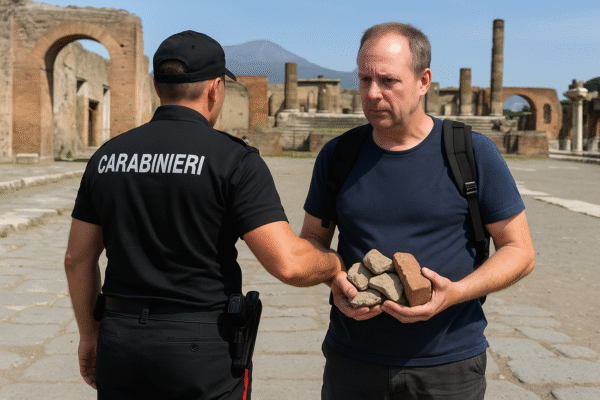For travellers, Pompeii offers a rare and exhilarating voyage back in time—one where the daily rhythms of ancient Roman life linger in frozen streets, frescoed walls, and crumbled mosaics. But a recent incident—where a 51-year-old Scottish tourist was apprehended while trying to remove stones and a brick fragment from the site—has jolted the tourism community and again raised the vital importance of preservation and respect in such a hallowed place.
The Incident That Could Have Born a Curse—or Worse
During a guided evening tour of the Archaeological Park of Pompeii, a vigilant tour guide observed the man picking up fragments of ancient pavement and placing them into a backpack. Authorities, alerted swiftly, intercepted him near the Villa dei Misteri EAV station. The six objects—five stone fragments and a brick—were confiscated and returned to the archaeological site. The tourist admitted he intended to gift them to his son, claiming ignorance of the law prohibiting removal of such artefacts.
Under Italy’s cultural heritage protection legislation, he now faces serious charges of aggravated theft—carrying a penalty of up to six years in prison and a fine as high as €1,500. The swift coordination between guides, site custodians, and the Carabinieri national police underscores the vigilance and readiness to protect this UNESCO World Heritage Site.
The Legend of Pompeii’s Curse
Beyond legal consequences, Pompeii holds a darker layer of lore—the so-called “curse.” Over the years, multiple visitors who took artefacts have later sent them back, citing a streak of misfortune. In one case, a Canadian woman returned items taken 15 years prior, along with a heartfelt apology, claiming her family suffered illness and financial ruin. The curse narrative has become a tool, too, for protecting the site—many regretful tourists return stolen pieces, hoping to ward off hexes while enabling authorities to preserve their context.
Preserving a World Heritage Marvel
Pompeii, buried in ash by Vesuvius’s eruption in AD 79, remained frozen in time until rediscovered centuries later—now serving as a vivid window into antiquity. Stunningly well-preserved, the site attracts millions annually—estimates range from over 2.5 million to nearly 4 million visitors, making it one of the world’s most popular archaeological destinations.
To counter overtourism and reduce wear and tear, authorities introduced a daily cap of 20,000 personalized tickets and a timed entry system—helping distribute crowds and better protect fragile ruins. The Soprintendenza Archeologica di Pompei, responsible for guiding excavations and preservation, actively updates access, ensuring only a portion of the vast site is accessible at once—minimizing exposure and damage.
For the Traveler: Visiting With Respect
If you’re planning to wander through Pompeii, here are essential guidelines to observe:
- Do not touch or remove any object, even seemingly loose stones. Every piece contributes to an irreplaceable mosaic of history.
- Follow guided routes and supervision—these paths are designed to protect both visitors and artefacts.
- Respect site rules—avoiding eating, drinking, or climbing on ruins helps maintain preservation.
- Stay curious, but cautious—questions are welcome, but hands should remain off the ancient structures.
Heritage Protection in Action
Beyond the park’s entry points, Italy employs specialized heritage protection forces. The Carabinieri Art Squad—esteemed as the world’s first dedicated cultural-heritage police unit—tracks, recovers, and safeguards stolen or illicitly trafficked artefacts, often coordinating with museums and auction houses. Their efforts have led to the return of items looted decades ago, including a recently repatriated mosaic panel that once belonged to a wartime-era Nazi looter, now displayed in Pompeii’s Antiquarium museum.
Additionally, the National Archaeological Museum of Naples is now showcasing hundreds of artefacts—once thought lost—recovered from the black market. These recovered items, ranging from Pompeian relics to archaic artworks, symbolize Italy’s dedication to reclaiming its past and making it accessible once more.
The Takeaway: Respect Through Reverence
Pompeii is not merely a tourist attraction—it is a sacred chronicle, entombed and resurrected, revealing ancient stories in every tumbled wall and preserved fresco. The recent attempted theft serves as a cautionary tale—not only due to potential jail time or fines, but also for what’s lost when artefacts lose their context. Responsible behavior in such spaces is not just encouraged—it is essential to preserving our collective human memory.
If you plan to walk these weathered cobblestones, embrace the privilege with humility. Let curiosity guide your gaze—not your fingertips. In doing so, you help ensure Pompeii’s legacy endures, uncorrupted and open, for centuries to come.
For more travel news like this, keep reading Global Travel Wire
















